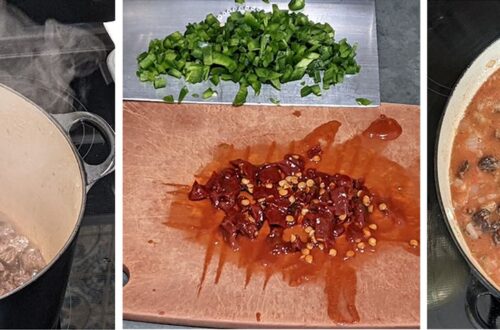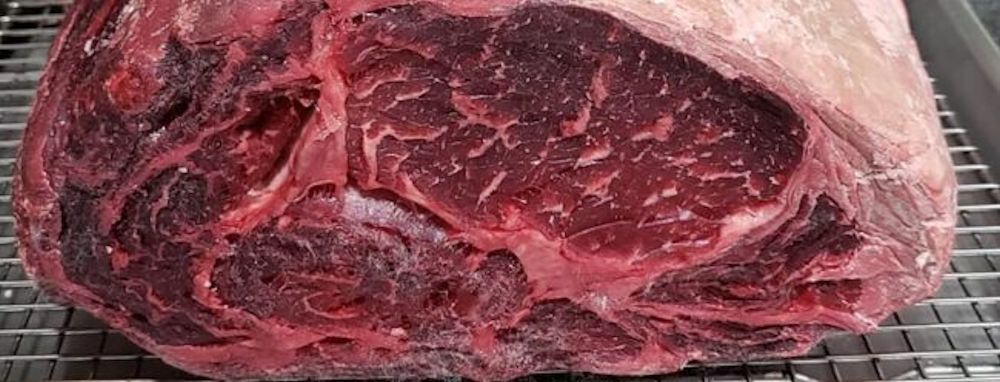
Bone-In Rib-eye Roast
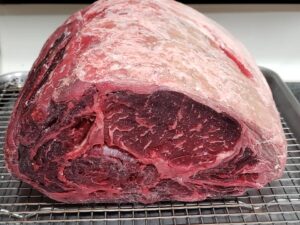
Often misnamed “Prime Rib”, the bone-in rib-eye is my favorite cut of beef. Whether as a steak or a roast, the rib-eye, with it’s distinctive wrapping of deckle* (otherwise known as rib-eye cap, or more formally, spinalis dorsi), is a particularly tender and is distinct in texture from the rest of the bone-in rib-eye.
When choosing a bone-in rib-eye, the first decision you’ll need to make is whether you want your roast from the small-end or large-end of the beef rib primal, which comes from the beef forequarter. It is separated from the beef chuck between the fifth and sixth ribs, and from the loin between the twelfth and thirteenth ribs, leaving ribs six through twelve (seven ribs in all). For some reason, probably because it is generally less fatty, the small-end will likely cost you a bit more per pound than the large end, but you’ll likely have less deckle with the more expensive small-end rib-eye. I prefer my roasts and steaks cut from the large end. The additional fat present during the roasting process provides additional flavor notes. Whether or not you also eat the fat (I certainly do) is up to you.
I buy my roast a week ahead of time so I can refrigerate it wrapped in cheesecloth in a baking sheet upon a flat cooling rack. A typical 8-9 pound three-rib roast should darken significantly in color and lose about half a pound of moisture during this period (see photo above).
First, remove from the refrigerator ahead of time, discard the cheesecloth, and allow to come to room temperature (or partially to room temperature).
Preheat your oven to 500°F. Meanwhile, season liberally with salt and pepper and place rib side down upon a roasting rack in a roasting pan.
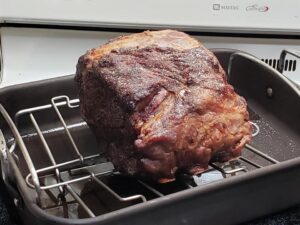
Place in oven and roast for 15 minutes to sear. remove from oven and lower oven temperature to 250° F. At this point, your roast will be completely raw inside but will look like this:
The reason for roasting at such a low temperature is so that you end up with slices of meat that are close to the same level of doneness almost all the way to the outside edge of the meat. If you roast at a higher temperature, you’ll have slices that are the desired doneness right in the middle but will immediately become more well-done as you get closer to the outside edge of the roast, leaving you with only a bite or two of the meat at your optimum level of doneness.
Once the temperature in the oven has dropped down to 250° F, place the roast back in the oven. Roast until the middle of your rib-eye has reached an internal temperature of 118° F, remove from oven and allow to rest for half an hour. It is important not to skip this step, because if you were to slice the roast immediately after taking it out of the oven, much of the juices within the meat will run out, and you’ll be left with a drier roast. Resting will reduce the amount of juices that will escape from the roast when slicing.
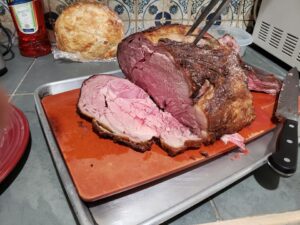
During this time the internal temperature, if you bother to monitor it, will rise another five degrees or so, leaving you with a roast that is halfway between rare (120° F) and medium rare (130° F). Use a carving knife to remove the ribs before slicing. The slices should look like so:
That’s all there is to it. If you’ve never prepared a bone-in rib-eye roast this way, well you’re about to partake in one of the truly great meals that lie within the capabilities of virtually any home cook.
Roast Potatoes on the Side
A simply prepared dish like this is the star of the show, and deserves an equally simple side. I’m a meat and potatoes guy, so I’ll usually roast up some potatoes while my roast is resting after its turn in the oven. First, place a large cast-iron skillet (or cast-iron pizza pan) in the oven and preheat to 425°F. while I wait for the oven to come to temp, I wash and slice my potatoes to approximately one inch pieces leaving the skin on.
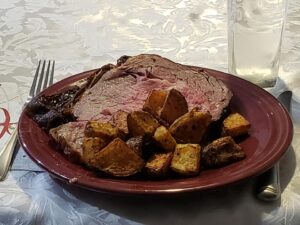 Then I place the potatoes in a bowl and add a generous amount of olive oil and season with salt, pepper, and paprika. I dump the entire mixture into the preheated cast iron, arrange in a single layer, and roast for 15 minutes. At that point, I use a metal spatula to turn over the potatoes, taking care not to leave potato bits stuck to the cast iron,and then roast for an additional 15 minutes. At that point, I remove them from the oven and serve immediately.
Then I place the potatoes in a bowl and add a generous amount of olive oil and season with salt, pepper, and paprika. I dump the entire mixture into the preheated cast iron, arrange in a single layer, and roast for 15 minutes. At that point, I use a metal spatula to turn over the potatoes, taking care not to leave potato bits stuck to the cast iron,and then roast for an additional 15 minutes. At that point, I remove them from the oven and serve immediately.
These photographs were taken on Christmas Day, 2020. If you give this recipe a shot, leave me a comment and let me know how it turns out. I’d love to see your photos!
Buon appetito!





